Please use this identifier to cite or link to this item:
https://accedacris.ulpgc.es/jspui/handle/10553/48191
| Title: | Life history of an anticyclonic eddy | Authors: | Sangrá Inciarte, Pablo Pelegrí Llopart,José Luis Hernández-Guerra, A. Arregui, Igor Martín, J. M. Marrero-Díaz, A. Martínez Marrero, Antonio Ratsimandresy, Andry W. Rodríguez-Santana, A. |
UNESCO Clasification: | 251007 Oceanografía física | Keywords: | Sea-Surface Temperature Gulf-Stream Meanders North-Atlantic Geostrophic Vortices Canary-Islands, et al |
Issue Date: | 2005 | Publisher: | 0148-0227 | Journal: | Journal of Geophysical Research | Abstract: | We use the trajectory of three buoys dragged below the surface mixed layer, together with sea surface temperature imagery, to examine the evolution of an anticyclonic warm-core eddy since its generation by the Canary Islands. Two buoys remain within the eddy during some 100 days, and the third one remains almost 200 days, while drifting southwestward up to 500 km with the mean Canary Current. The eddy merges with several younger anticyclonic and cyclonic eddies, in each occasion, suffering substantial changes. The eddy core, defined as a region with near-solid-body-type rotation and radial convergence, initially occupies the whole eddy. After interacting with another vortex the inner core markedly slows down, although it continues displaying radial convergence and relatively small radial oscillations, and an uncoupled outer ring is formed or enhanced, which revolves even more slowly and displays large radial fluctuations. The vortex extensive life is consistent with its inertially stable character and observations of radial convergence. A very simple model of vortex merging, where cylinders fuse conserving mass and angular momentum, gives fair results. The observations suggest that the eddy changes, as the result of its own slow evolution and sporadic mixing events, from a young stage, where the core retains its vorticity and occupies most of the eddy, through a mature stage, where the eddy has a reduced inner core and a slowly revolving outer ring, to a decay stage, where the vorticity maximum is substantially reduced. | URI: | https://accedacris.ulpgc.es/handle/10553/48191 | ISSN: | 0148-0227 | DOI: | 10.1029/2004JC002526 | Source: | Journal of Geophysical Research C: Oceans [ISSN 0148-0227], v. 110, p. 1-19 |
| Appears in Collections: | Artículos |
SCOPUSTM
Citations
72
checked on Jun 8, 2025
WEB OF SCIENCETM
Citations
76
checked on Jun 8, 2025
Page view(s)
118
checked on Jun 1, 2024
Download(s)
197
checked on Jun 1, 2024
Google ScholarTM
Check
Altmetric
Share
Export metadata
Items in accedaCRIS are protected by copyright, with all rights reserved, unless otherwise indicated.
